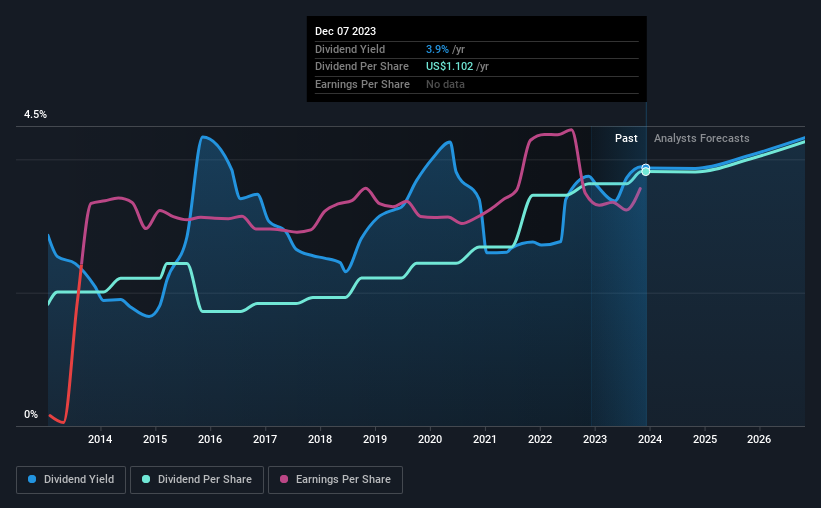There's A Lot To Like About HP's (NYSE:HPQ) Upcoming US$0.28 Dividend
Regular readers will know that we love our dividends at Simply Wall St, which is why it's exciting to see HP Inc. (NYSE:HPQ) is about to trade ex-dividend in the next four days. Typically, the ex-dividend date is one business day before the record date which is the date on which a company determines the shareholders eligible to receive a dividend. The ex-dividend date is of consequence because whenever a stock is bought or sold, the trade takes at least two business day to settle. Accordingly, HP investors that purchase the stock on or after the 12th of December will not receive the dividend, which will be paid on the 3rd of January.
The company's next dividend payment will be US$0.28 per share, on the back of last year when the company paid a total of US$1.10 to shareholders. Based on the last year's worth of payments, HP has a trailing yield of 3.9% on the current stock price of $28.49. We love seeing companies pay a dividend, but it's also important to be sure that laying the golden eggs isn't going to kill our golden goose! So we need to check whether the dividend payments are covered, and if earnings are growing.
View our latest analysis for HP
Dividends are usually paid out of company profits, so if a company pays out more than it earned then its dividend is usually at greater risk of being cut. HP paid out a comfortable 32% of its profit last year. That said, even highly profitable companies sometimes might not generate enough cash to pay the dividend, which is why we should always check if the dividend is covered by cash flow. Thankfully its dividend payments took up just 35% of the free cash flow it generated, which is a comfortable payout ratio.
It's positive to see that HP's dividend is covered by both profits and cash flow, since this is generally a sign that the dividend is sustainable, and a lower payout ratio usually suggests a greater margin of safety before the dividend gets cut.
Click here to see the company's payout ratio, plus analyst estimates of its future dividends.
Have Earnings And Dividends Been Growing?
Companies that aren't growing their earnings can still be valuable, but it is even more important to assess the sustainability of the dividend if it looks like the company will struggle to grow. If earnings decline and the company is forced to cut its dividend, investors could watch the value of their investment go up in smoke. With that in mind, we're not enthused to see that HP's earnings per share have remained effectively flat over the past five years. It's better than seeing them drop, certainly, but over the long term, all of the best dividend stocks are able to meaningfully grow their earnings per share. Recent earnings growth has been limited. However, companies that see their growth slow can often choose to pay out a greater percentage of earnings to shareholders, which could see the dividend continue to rise.
Many investors will assess a company's dividend performance by evaluating how much the dividend payments have changed over time. Since the start of our data, 10 years ago, HP has lifted its dividend by approximately 7.6% a year on average.
Final Takeaway
Is HP worth buying for its dividend? The company has barely grown earnings per share over this time, but at least it's paying out a decently low percentage of its earnings and cashflow as dividends. This could suggest management is reinvesting in future growth opportunities. Generally we like to see both low payout ratios and strong earnings per share growth, but HP is halfway there. HP looks solid on this analysis overall, and we'd definitely consider investigating it more closely.
With that in mind, a critical part of thorough stock research is being aware of any risks that stock currently faces. To that end, you should learn about the 5 warning signs we've spotted with HP (including 2 which are potentially serious).
A common investing mistake is buying the first interesting stock you see. Here you can find a full list of high-yield dividend stocks.
Have feedback on this article? Concerned about the content? Get in touch with us directly. Alternatively, email editorial-team (at) simplywallst.com.
This article by Simply Wall St is general in nature. We provide commentary based on historical data and analyst forecasts only using an unbiased methodology and our articles are not intended to be financial advice. It does not constitute a recommendation to buy or sell any stock, and does not take account of your objectives, or your financial situation. We aim to bring you long-term focused analysis driven by fundamental data. Note that our analysis may not factor in the latest price-sensitive company announcements or qualitative material. Simply Wall St has no position in any stocks mentioned.

 Yahoo Finance
Yahoo Finance 
